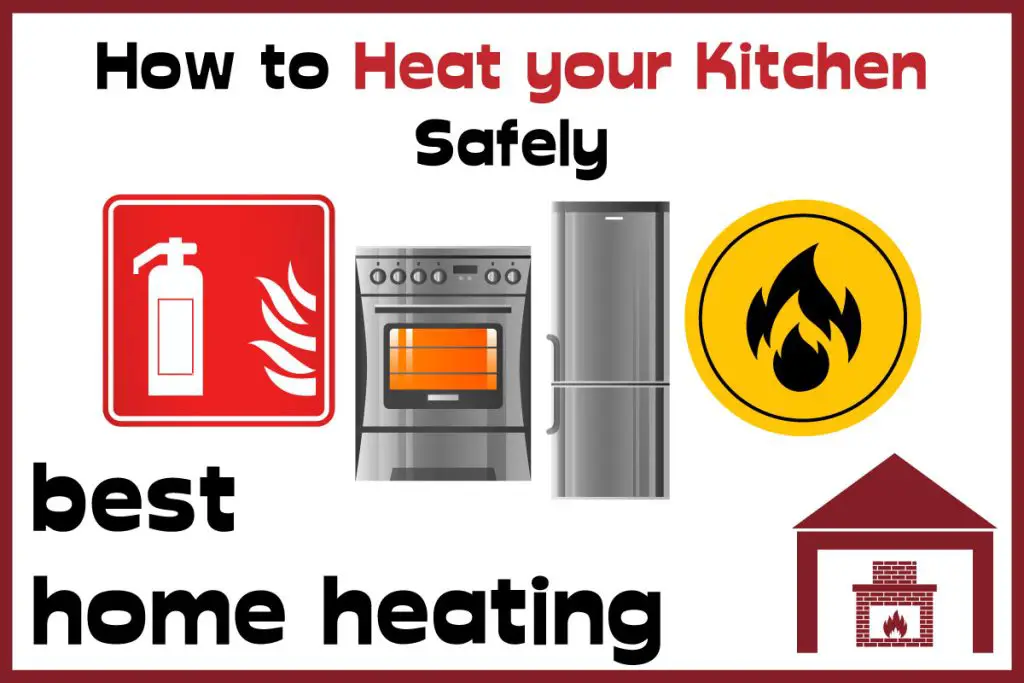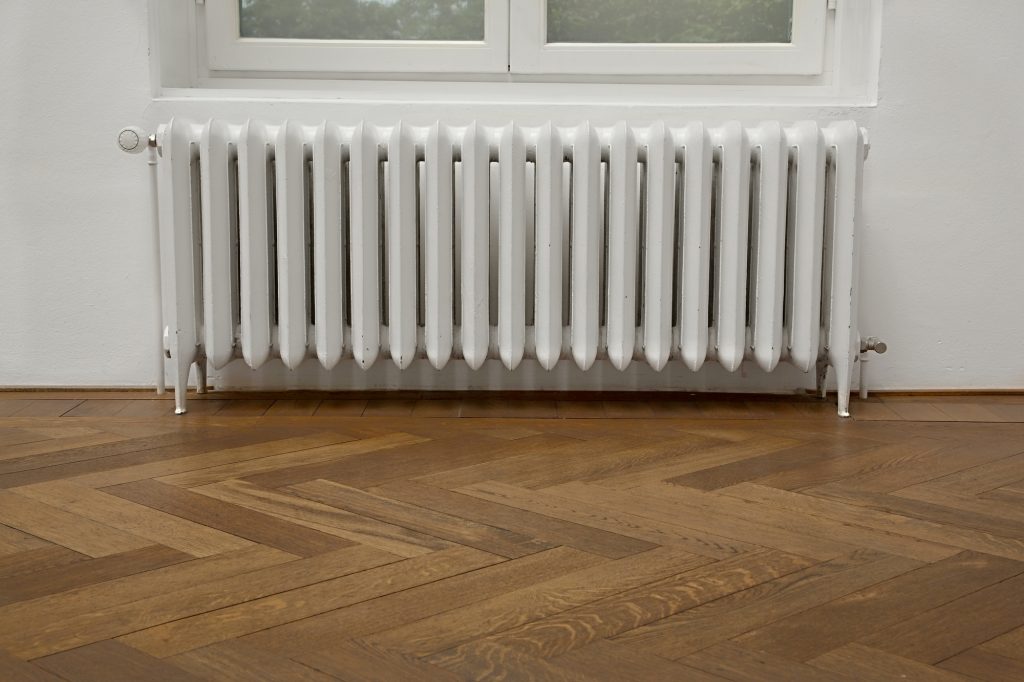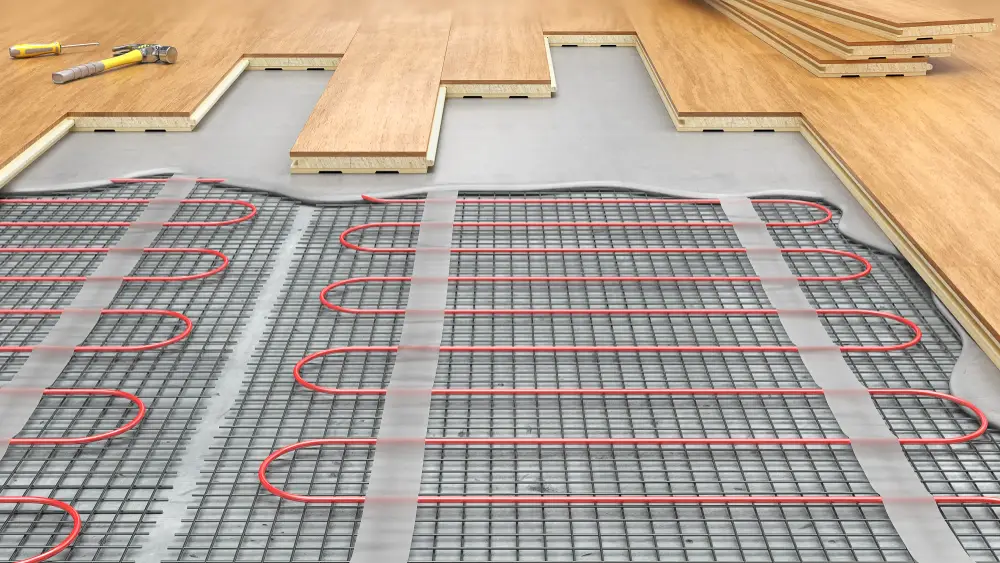When selecting a heating system for your kitchen, it is crucial to prioritize safety since various heating options exist, and not all of them are equally safe; in fact, some methods can be outright hazardous.
Various popular heating systems: radiators, underfloor heating, range heaters, plinth heaters, heated glass, wood-burning stoves, fireplaces, kerosene/propane heaters. Safest: radiators, underfloor heating, plinth heaters, heated glass. Less safe: wood-burning stoves, oil-burning heaters, fireplaces.
Discover more about how to safely heat a kitchen and steer clear of five potential kitchen heating safety hazards by reading on.
| Heating System | Safety Plus Points (Pros) | Safety Hazards (Cons) |
| Radiators | They are stationed in a fixed spot, hence they do not come in contact with flammable items. There is no risk of a gas leak. | Electrical Malfunction in electric radiators can lead to fire outbreak(uncommon). |
| Underfloor Heating | No risk of a gas leak. No emissions, very clean. It is placed below the floor, hence there is no risk of burns. | It can affect the integrity of the floor(e.g tiles), especially when it is installed directly under fixed furniture or heavy appliances. |
| Plinth Heaters | It can be placed in small kitchens and it does not restrict movement in the event of an emergency. | No potential glaring hazards. |
| Electrically Heated Glass | There is no possibility of fire hazards or scalding. No risk of Electrocution. | No potential glaring hazards. |
| Stoves | Its usage is not applicable for heating kitchens. | It can lead to carbon monoxide poisoning after prolonged use. It can lead to fire outbreak if it is not properly controlled. |
| Space Heaters | Its usage is not applicable for heating kitchens. | There is a high risk of fire hazards. The electrical cords of this device can cause people to trip. |
| Fire Places | Its usage is not applicable for heating kitchens. | It can lead to fire outbreak if it is not properly controlled. |
Many homeowners make the mistake of choosing unsafe heating systems, and in some cases the wrong decisions lead to hazards. If you are willing to learn more about the safe and unsafe heating methods for a kitchen and avoid safety hazards, this post is for you.

Radiators
Radiators work through convection—a heat transfer process. Pipes are used to connect radiators to a central heating system. When the system is on, the water flowing through the radiators gets hot. The convector then passes this heat to the surrounding air.
There are also electric radiators that use a thermodynamic fluid. As electric current passes through the system, the fluid heats up and thus warms the surrounding air.
Using radiators is a safe way to heat a kitchen. Radiators are installed on the walls, and therefore do not usually come in contact with flammable items. There is no gas, and therefore no risk of gas leaks.
In electric radiators, the elements are protected. And when a radiator is professionally installed, a rigorous safe procedure is followed.
However, if installed and operated incorrectly, radiators can be a safety hazard. Internal circuit malfunction is possible, and that can cause fires. But this is just a possibility. In general, radiators are considered among the safest heat emitters.

Underfloor heating
There are two types of underfloor heating (UFH) systems: hydronic and electric. A hydronic system works by distributing warm water through pipes installed beneath the floor. The pipes are connected to a central heating system or heat pump.
An electric system, in contrast, involves laying down electric heating mats beneath the floor. The heat is controlled by a smart thermostat. Installing UFH is one of the safest ways to heat a kitchen. There is no risk of a fire or electric shock.
However, if installed incorrectly, UFH can be a safety hazard, damaging wooden flooring. A rapid change in temperature, which can occur if there is an issue with the thermostat, can cause strain on some types of wood. With that said, if you notice an uneven distribution of heat, you can address the issue before something bad happens.
If the system is constantly at a high temperature, it can cause tiled flooring to crumble. This hazard can be prevented by choosing tiles that are designed to withstand high temperatures.
Here is another thing: you can’t place flat-bottomed furniture and other items on underfloor heating. While it may not lead to fire hazards, the efficiency of your underfloor heating will be greatly compromised.

Plinth Heaters
Using a plinth heater is one of the safest ways to heat a kitchen. It is a very good option for a kitchen with limited wall space because the unit can be nicely fitted in the plinth area. It works by drawing cold air in, warming the air, and then passing it out.
There are two parts of a basic plinth heater: a heating element and a thermostat. Even if misused, a plinth heater poses little to no risk of fire.
With that said, it is good to be careful with something as safe as a plinth heater. First of all, do not obstruct the air movement of the heater. The distance between your plinth heater and other items, particularly flammable items, should be at least 6 inches.
If you have multiple plinth heaters installed in your kitchen, use a single thermostat to control them. And tell kids to stay away from the plinth heater, not because it is dangerous, but simply because it is a source of heat.
Electrically Heated Glass
Looking for a more modern and sophisticated way to heat your kitchen? Consider installing electrically heated glass—a special type of glass with a transparent coating that converts electricity into heat.
The transparent glass emits radiant heat, keeping your kitchen comfortably warm while preventing condensation and snow. The technology also eliminates heat loss, drafts, and chills.
Electrically heated glass eliminates the need for any other heating system in the room, and that’s part of the reason homeowners who value aesthetic appeal opt for this option.
The conducting element is placed within multiple layers of insulated glass, and therefore it is safe to touch the glass. There is no possibility of fire hazards or scalding.
5 Heating Methods to avoid due to Safety Concerns
Some heating systems can be outright dangerous when used to heat a kitchen. Here are the options to avoid at all costs:
1. Stoves
Any device that is designed for cooking should not be directly used to heat your kitchen. It’s inefficient, and in some cases, it can lead to carbon monoxide poisoning. If a gas stove runs for hours at a stretch, at a point it will burn all the oxygen in the kitchen and thus produce carbon monoxide. Inhaling large amounts of carbon monoxide can be fatal.
2. Fireplaces
Using a fireplace is not a smart way to heat your kitchen. In a modern kitchen with good insulation, this approach can be extremely dangerous. So, unless you have a large kitchen with proper ventilation, do not even think of using a fireplace. It is also inefficient as it lets out plenty of heat.
3. Kerosene or Propane Heaters
Using a kerosene or propane heater to heat your kitchen is a terrible idea. These heaters need proper ventilation to function safely, and that’s why they are mostly used outdoors. Even if your kitchen is well-ventilated, there is a risk of a gas leak. Such a heater can be used as a temporary solution in some cases, such as after a natural disaster. But it should not be used as the primary heat source for your kitchen or home.
4. Space Heaters
When paired with extensive cords, an electric space heater can become dangerous, in part because it can generate too much heat for an average power strip. So, there is a real risk of fire hazards. Using a space heater in a kitchen is unsafe also because you may accidentally trip over the cords.
5. Malfunctioning HVAC systems
Any malfunctioning heating system is a safety hazard. A broken wire or dirty filter may not seem a big deal, but in fact, it can be dangerous. If you ignore these problems for too long, there are real risks of CO poisoning and other dangers.
The good news is, that most modern heating systems are easy to maintain. Many heating systems come with sophisticated features that detect issues automatically. No matter what type of heating system you are using, get it serviced at regular intervals, at least once a year, even if the system seems smoothly functional.
Conclusion
Safety should be an important consideration when choosing a heating system for your kitchen. No heating system is 100% safe, but some are very safe while some are potentially dangerous and should be avoided at all costs.
We have shed light on both safe and unsafe ways to heat a kitchen, and we hope you are now better prepared to make an informed decision.
